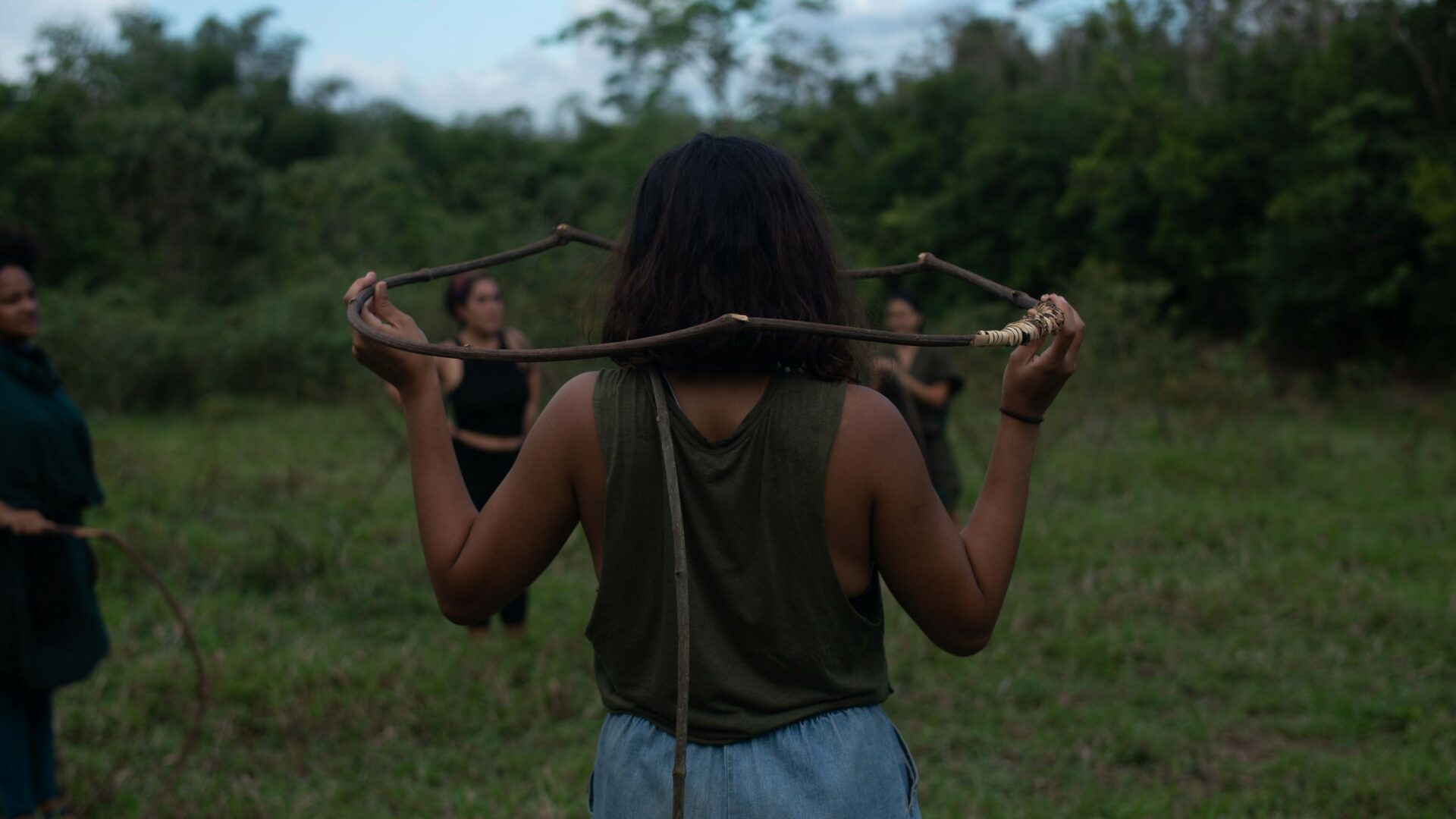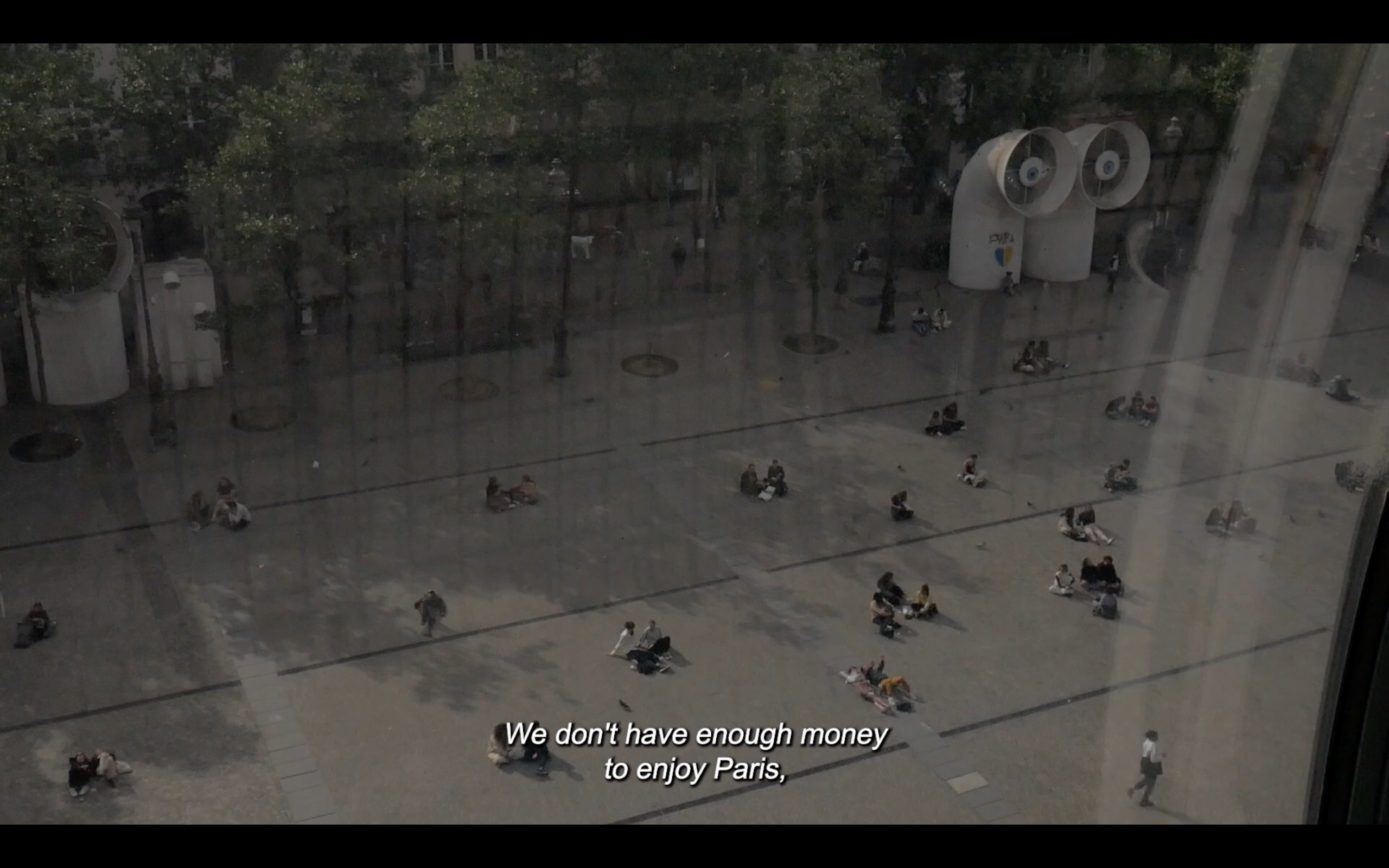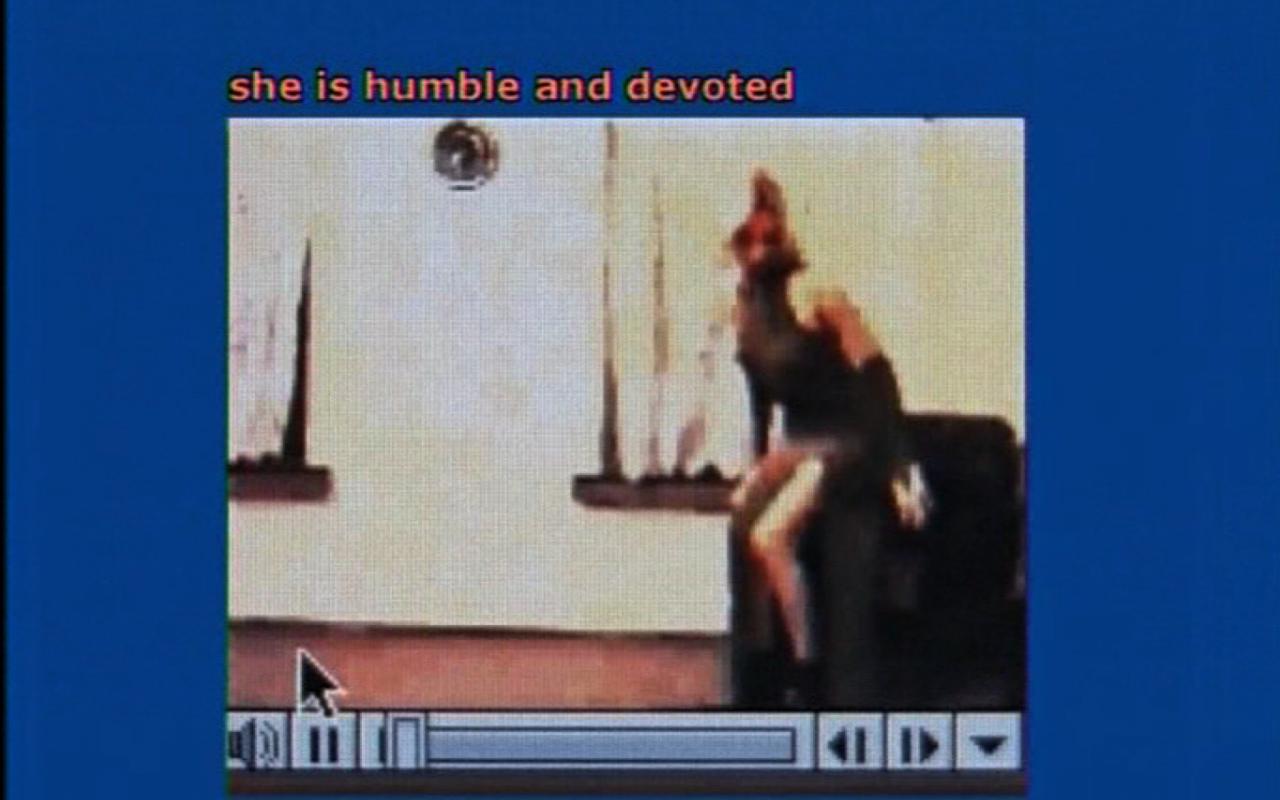

Fernanda Brenner, artistic director of Pivô, and Niels Van Tomme, curator of Argos, collaborated with Beatriz Santiago Munõz in the creation of a new installation version of Oriana, the artist’s first feature film, from 2022. After an initial presentation at Pivô in São Paulo, Santiago Munõz filmed extra scenes and these were added to the original material, creating an intricate audiovisual experience through the two floors of the Argos building, in Brussels (Belgium). The exhibition is on display at Argos partner until May 7, 2023.
This interview by Caroline Goudart with Beatriz Santiago Muñoz is part of the exhibition and the immersion in Oriana and in the artist’s creative process. It was translated to Portuguese to be posted on the Pivô website.
CG. Your latest film, Oriana, is largely inspired by Monique Wittig’s 1969 novel Les Guérillères. When did you first read the book? In what context? And what was the effect of the text on you?
BSM. I first read it in college at the University of Chicago. The book had been assigned in a class called “Feminist Theory, Feminist Practice,” taught by the late Lauren Berlant. When I first read it, in English, I was shocked by what the text was doing formally. Wittig’s experiment in form really opened up a different way of naming the world for me, and I tried to understand its mechanics, how it was made and how it worked. I loved it so much that I ended up stealing my roommate’s copy. It was the first time I read something that proposed a formal experiment that I didn’t need to understand intellectually for it to function. My faith in formal experimentations comes from my encounter with that book, and even though I had never thought of turning it into a film, I realized that I wanted to come back to it, understand it deeply and create an analogue of it.
CG. Has your relationship to the book evolved since you first encountered it??
BSM. Yes, it went from visceral love at first to slowly understanding the philosophical questions, and then the technical ones. It’s become clear to me that Wittig had to solve certain problems with technique, that she had to make strong formal decisions. For instance, she uses the pronoun “elles” up to about two-thirds of the book; in other words, she sets up a world where “elles” is the assumed subject. “He” comes later and is a singular. It’s very much a technical decision, she clearly wondered what effect this would have on the readers. I wonder what she would make of the questions of gendered pronouns right now. She had very interesting positions on sexual difference and language, and I can only imagine that her thinking would have continued to evolve had she lived longer, as I’m sure it did when she moved to Arizona and was confronted with different approaches to questions
of race.
CG. What aspects of the book were important to you in this process of translation from text to film?
BSM. I was very interested in Wittig’s notion of a collective, universal subject made of singular names that stands outside of the male-female binary. This goes straight against the narrative expectations of film, where you’re supposed to follow a character and their evolution. There are many others, some of which I don’t yet understand. Wittig uses the pronoun “elles,” which is translated as “the women” in English, and in Spanish as “ellas.” But Wittig herself said that maybe “elles” should have been translated as “they” because she was interested in a beyond-gender. Les Guérillères is historically grounded: it came out in 1969, and is rooted in specific debates about language, how we use it to construct the world, how it traps us and what may lie beyond it. I’m interested in these questions, but it’s very difficult to transfer them to film, as an image will get away from the sign much faster than words. I had to transform the questions and the assumptions behind
these questions because images work differently. Further, I’m interested in the collage method, as the text, which is not linear, often evokes the cut-up: at first, the text feels like a post-war world but then time becomes cyclical, and the text turns into an epic of sorts. I also wanted to convey the idea of a cyclical time, a constant strolling with the problem, rather a march toward progress. The epic feeling in the book doesn’t come from its length but from the scope of people, names, sensual experiences, etc. I wanted to explore ways in which the performance might convey this idea of the epic, so I included moments of fury in the film in collaboration with dancers. I also love the self-questioning that you find in the book, where characters will make quick claims and then question those claims immediately. These are philosophical movements that happen in very compressed space-times.
CG. In Oriana, you’ve wanted to produce a video analogue of the book. What do you mean by
that, and how is that different from an adaptation?
BSM. I only use 800 words from the book in the film. Instead of an adaptation in the classical sense, my purpose was to explore the questions that the text tries to answer in film form. I started by figuring out what the questions were and then tried to ask them cinematically. But of course, the questions are not clear, and neither are the answers… One question I found fascinating was that of the collective subject and how it could be represented in the film: in contrast to classical modes of characterization, the collective subject has no interiority, we never approach it through close ups that reveal interior states or particularly expressive moments, and we do not get to wonder what a specific character’s process of transformation might be. They are characterized only by their actions and how they relate to each other. Similarly, there’s no clear border between a singular person and their environment, be it the fruit they’re eating or the water in which they’re bathing: there is no
clear subject that could be abstracted from the place. As I was making the film, as saw each idea in the text as a proposal, an instruction that I tried to follow.
CG. Representing women on screen without objectification, creating a sense of desire without the
male gaze is the central challenge of feminist film practices. What has been your reflection on this
question? What aesthetic devices and strategies did you develop in this piece?
BSM. This is not a question that is raised in the text, but of course it appears by necessity when you work with film. I don’t have an overarching approach to it: rather, my strategies are contingent and evolve from scene to scene. Let me give you an example: at the beginning of the film, there is a moment where the characters bathe after the battle. They are receiving the rays of the sun, sitting in the river, their bodies are resplendent. This image has an undeniable sexual attraction to it. But how
you receive it depends on how you have been positioned as a viewer. Following Wittig’s thinking, I wanted to present the viewer with a universal subject that is neither female nor male. Of course, this can only function if the film has created a world in which a beyond-gender is possible, for instance through how the characters look and respond to each other. What I aimed to do was to
invite the spectators themselves to identify with a different kind of subject, to embody spectatorship differently. That is what the book does: in the course of reading the text, you come to identify as a different kind of subject than who you had been up to that point. And this is why this book remains so important: it’s a space you can enter and breathe freely for a moment.
CG. The book and the film take place in the “Amazonian”, a faraway imaginary space for Wittig, but for you the tropical forest is a part of the place where you live and work. Can you tell me more about that process of transposition?
BSM. I felt invited to think about the interaction between thinking and landscape because the text
attempts to describe all these tribes of women in different places. But at times, the tropical
landscapes fall a bit flat in the text: you’ll picture warriors organizing themselves with fantastic
weapons, but the descriptions of their surroundings are not as rich as those of the places Wittig
knew very well, like Alsace. Still, she tries to imagine them, which felt to me like an invitation to
reflect on how her ideas might transform if we thought of them directly from the tropics, from
Puerto Rico. What happens is that the setting and the group of women that we see transform the
imagined centre of the text.
CG. How did you work with the actresses?
BSM. I sometimes would ask the performers to improvise, to start from something in the text and
use it as a basis to imagine another kind of speech. That’s where the starkest differences between
the text and my film are situated, you notice them more in the moments where the actresses are
speaking and improvising. Improvisation is crucial to me, as well as delightful: it feels like someone
else is presenting the film to you. I love those surprises. For instance, I had asked Ivette Román, a
vocal performer to produce a kind of “song of the beginning of language.” She created an amazing
15-minute-long performance in which she gradually transforms very basic sounds into a kind of
anthem. Here as elsewhere, my goal has been to amplify suggestions from the text, and in that
sense it’s not an adaptation: the film is inspired by the text.
CG. I’m intrigued by your aesthetic choices: in many ways, the film looks like it was made in the 70s.
BSM. I wanted it to feel like the early 70s had come to visit. I love sci-fi films from that era and
wanted to recreate that look and feel by working with very simple effects. For instance, the cosmos
scene is shot in a fish tank. I wanted to see how much of the film could be made as a collective
process instead of isolated work in post-production. I usually work with very little, I don’t even use
artificial lights, let alone drones or aerial shots. The film is generated with very simple methods:
natural light, a camera on a tripod, simple movements. It is the richness of the sound that conveys
the visceral affectivity.
CG. Can you tell us about the soundtrack, which is at once gorgeous and disorienting?
BSM. The soundtrack is made of different layers. Joel Rodriguez, who did the field recording during
the shoot, added a second layer of sound effects afterwards. The music was composed and recorded
by a band name Rakta that is based in Sao Paolo. For the sound design, I wanted a purposeful
confusion of scale and distance, so that what you hear would seem to be much closer than what the
image suggests. I also wanted to create relationships between actions and sounds that are not
necessarily logical. To me, this creates a “beyond,” a kind of sci-fi space, and it does something that
words on a page can do as well: flattening out a sign or clarifying it, creating a kind of Brechtian
distance that takes away from the expectation of naturalism that a camera can have. Rakta’s music
also references natural materials but brings them into a kind of epic rhythm. They create an epic
scale with sound.
This interview is a collaboration between argos and the film publication Fantômas. The Dutch version
will also be published on the website www.fantomas.be.

 Português
Português
